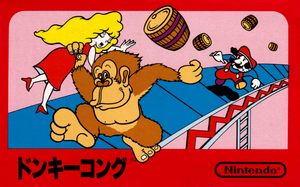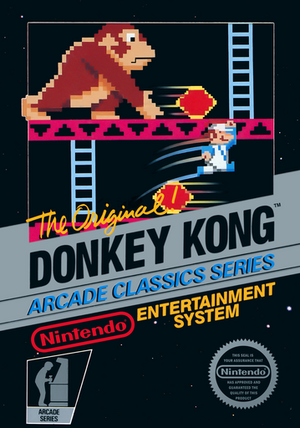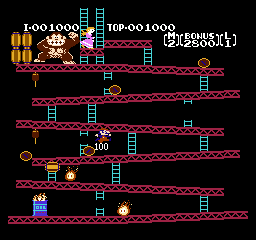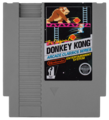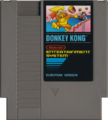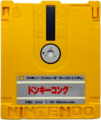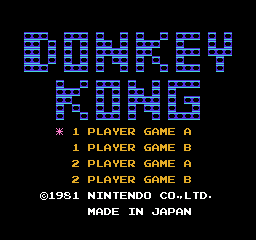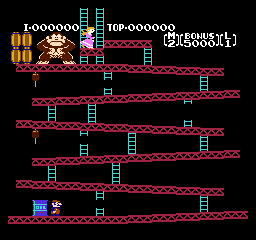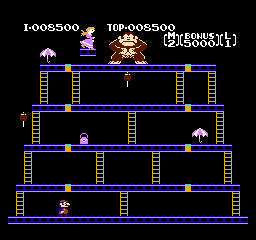Donkey Kong: Difference between revisions
mNo edit summary |
m (software) |
||
| (5 intermediate revisions by the same user not shown) | |||
| Line 37: | Line 37: | ||
<small>''Donkey Kong redirects here. For other pages, see [[Donkey Kong (disambiguation)]].''</small><br> | <small>''Donkey Kong redirects here. For other pages, see [[Donkey Kong (disambiguation)]].''</small><br> | ||
'''''Donkey Kong''''' (ドンキーコング) is a platformer developed by [[Nintendo R&D2]] and published by [[Nintendo]] and released for the [[Family Computer]] on July 15, 1983 in Japan. It would later release for the [[Nintendo Entertainment System]] on June 15, 1986 in North America and on October 15, 1986 in Europe. The game would also release for the [[Family Computer Disk System]] on April 8, 1988 in Japan. It is a port of {{wp|Donkey_Kong_(video_game)|the 1981 arcade game of the same name}}. Donkey Kong features the first appearance of future Nintendo mascot [[Super Mario Bros.|Mario]]. It was one of three launch games released for the Famicom. | '''''Donkey Kong''''' (ドンキーコング) is a platformer developed by [[Nintendo R&D2]] and published by [[Nintendo]] and released for the [[Family Computer]] on July 15, 1983 in Japan. It would later release for the [[Nintendo Entertainment System]] on June 15, 1986 in North America and on October 15, 1986 in Europe. The game would also release for the [[Family Computer Disk System]] on April 8, 1988 exclusively for the [[Disk Writer]] in Japan. It is a port of {{wp|Donkey_Kong_(video_game)|the 1981 arcade game of the same name}}. Donkey Kong features the first appearance of future Nintendo mascot [[Super Mario Bros.|Mario]]. It was one of three launch games released for the Famicom. | ||
==Gameplay== | ==Gameplay== | ||
[[File:Donkey Kong FC Gameplay Screenshot.png|thumb|256px|left|Screenshot of the 25m stage where Mario jumps over a barrel.]] | [[File:Donkey Kong FC NES Gameplay Screenshot.png|thumb|256px|left|Screenshot of the 25m stage where Mario jumps over a barrel.]] | ||
Donkey Kong is a single screen platformer. There are 3 unique stages (one less than the original arcade game) that the game cycles through throughout play. The player plays as Mario as he progresses each stage to save Lady (later renamed Pauline) from the titular Donkey Kong. Mario can jump and climb ladders to traverse through the stage. Barrels and other objects are used by Donkey Kong to stop his progress. Hammers can be found in each level which can destroy these objects, awarding points. Points are also granted from collecting additional items in the level, jumping over obstacles, and completing a stage. | Donkey Kong is a single screen platformer. There are 3 unique stages (one less than the original arcade game) that the game cycles through throughout play. The player plays as Mario as he progresses each stage to save Lady (later renamed Pauline) from the titular Donkey Kong. Mario can jump and climb ladders to traverse through the stage. Barrels and other objects are used by Donkey Kong to stop his progress. Hammers can be found in each level which can destroy these objects, awarding points. Points are also granted from collecting additional items in the level, jumping over obstacles, and completing a stage.{{clear}} | ||
==Reception== | ==Reception== | ||
| Line 71: | Line 64: | ||
Donkey Kong FDS Disk.png|The Disk System disk card. | Donkey Kong FDS Disk.png|The Disk System disk card. | ||
</gallery> | </gallery> | ||
'''Screenshots''' | |||
<gallery widths=256px heights=240px> | |||
Donkey Kong FC NES TitleScreen.png|The Famicom and NES title screen. | |||
Donkey Kong FDS TitleScreen.png|The Disk System title screen. | |||
Donkey Kong FC NES 25m Screenshot.png|The 25m stage. | |||
Donkey Kong FC NES 50m Screenshot.png|The 50m stage. | |||
Donkey Kong FC NES 100m Screenshot.png|The 100m stage. | |||
Donkey Kong FC NES Ending Screenshot.gif|The ending screen. | |||
</gallery> | |||
{{1983 software}} | |||
[[Category:Nintendo e-Reader software]] | [[Category:Nintendo e-Reader software]] | ||
[[Category:Famicom Mini series software]] | [[Category:Famicom Mini series software]] | ||
[[Category:Classic NES Series software]] | [[Category:Classic NES Series software]] | ||
[[Category:Nintendo Switch Online software]] | [[Category:Nintendo Switch Online software]] | ||
Latest revision as of 05:09, 19 June 2024
ドンキーコング
Donkey Kong redirects here. For other pages, see Donkey Kong (disambiguation).
Donkey Kong (ドンキーコング) is a platformer developed by Nintendo R&D2 and published by Nintendo and released for the Family Computer on July 15, 1983 in Japan. It would later release for the Nintendo Entertainment System on June 15, 1986 in North America and on October 15, 1986 in Europe. The game would also release for the Family Computer Disk System on April 8, 1988 exclusively for the Disk Writer in Japan. It is a port of the 1981 arcade game of the same name. Donkey Kong features the first appearance of future Nintendo mascot Mario. It was one of three launch games released for the Famicom.
Gameplay
Donkey Kong is a single screen platformer. There are 3 unique stages (one less than the original arcade game) that the game cycles through throughout play. The player plays as Mario as he progresses each stage to save Lady (later renamed Pauline) from the titular Donkey Kong. Mario can jump and climb ladders to traverse through the stage. Barrels and other objects are used by Donkey Kong to stop his progress. Hammers can be found in each level which can destroy these objects, awarding points. Points are also granted from collecting additional items in the level, jumping over obstacles, and completing a stage.
Reception
US: Nintendo Power would rate the separate game in their 1990 Pak Source, giving it a score spread of 3/3.5./3.5/3.5 across graphics & sound, play control, challenge and theme & fun.
UK: Nintendo Magazine System included the game in the index of their initial October 1992 issue. They rated it 45%, citing 'four arcade screens of arcade action simply isn't enough to warrant the price tag'.
Gallery
Box artwork
Cartridges and Disk
Screenshots
